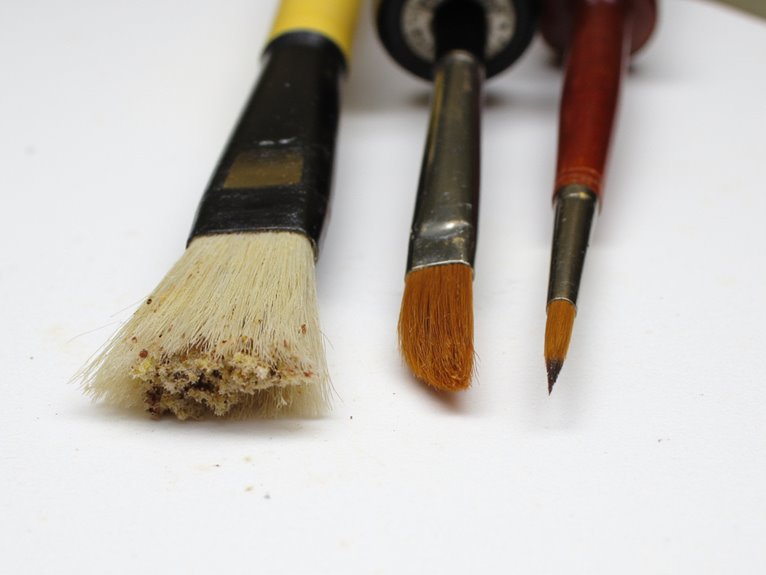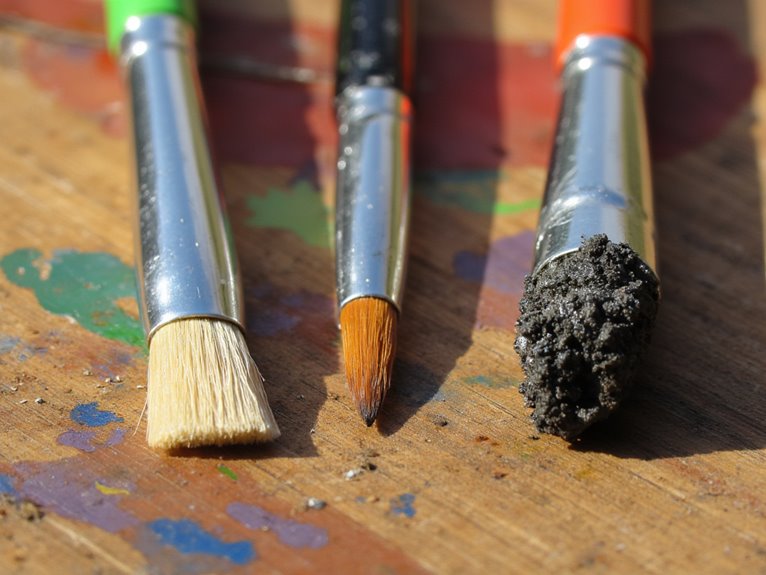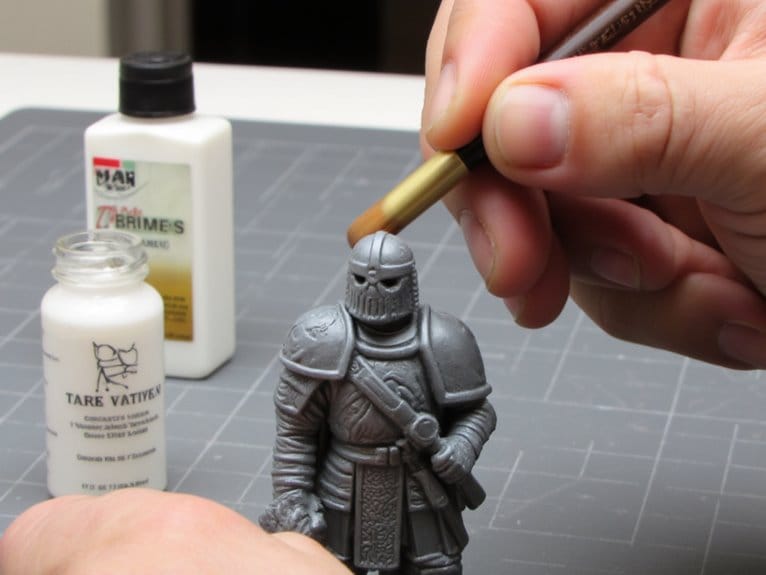We are supported by our audience. When you purchase through links on our site, we may earn an affiliate commission, at no extra cost for you. Learn more. Last update on 1st July 2025 / Images from Amazon Product Advertising API.
You’ll need to replace your miniature brush when bristles shed excessively during painting, leaving marks in your work, or when tips become frayed and split, preventing precise detail work. Watch for brushes that can’t regain their pointed shape after cleaning, indicating permanent deformity. Paint residue buildup in the ferrule weakens structure, while stiffened bristles reduce flexibility and paint-holding capacity. With proper care, quality brushes last six months to two years depending on usage frequency and paint types, though specialized techniques can extend their lifespan considerably.
Notable Insights
- Replace brushes when bristles shed excessively during use, contaminating paint and leaving unwanted marks on miniatures.
- Replace when brush tips become hardened, split, or frayed, preventing smooth detail work and clean strokes.
- Replace brushes that fail to regain their pointed shape after cleaning, indicating permanent bristle deformity.
- Replace when paint residue builds up in the ferrule, causing structural weakness and reduced paint-holding capacity.
- Replace brushes every six months with regular use, or one to two years for daily painters with proper care.
Clear Warning Signs Your Brush Needs Replacement
While a high-quality miniature brush can last months or even years with proper care, several clear indicators signal when it’s time for replacement.
Excessive bristle shedding presents the most obvious replacement trigger. You’ll notice loose hairs contaminating your paint and leaving unwanted marks on miniatures. The brush lifespan considerably decreases when bristles become hardened, split, or develop frayed tips that prevent smooth detail work.
Paint residue buildup in the ferrule area creates structural weakness and bristle stiffening. Brushes that won’t regain their original pointed shape after cleaning have reached permanent deformity. When paint dries in the bristles despite cleaning attempts, the brush has suffered irreversible damage.
Performance decline manifests as difficulty achieving clean strokes and reduced paint-holding capacity. When your brush feels clumsy or unresponsive during application, it’s compromising your painting quality and efficiency. Remember that negative self-talk about your painting abilities may actually indicate tool problems rather than skill issues.
Quality brushes with rust-proof ferrules and proper maintenance will show fewer signs of deterioration, but even premium brushes eventually succumb to wear from regular use.
How Paint Type and Application Methods Affect Brush Longevity

Understanding these replacement indicators helps you recognize when a brush has reached the end of its useful life, but several factors determine how quickly you’ll encounter these warning signs.
Paint thickness impact greatly affects brush longevity. Heavy body acrylics and oils create more resistance, causing faster bristle wear than fluid paints. Metallic paints contain abrasive flakes that fray delicate miniature brush tips.
Application pressure effects accelerate damage when you press too hard or use only the brush tip. This creates uneven wear and bristle curling. Synthetic brushes offer greater durability for tasks involving heavy application pressure compared to natural bristle alternatives.
| Paint Type | Brush Impact | Cleaning Requirements | Recommended Brush |
|---|---|---|---|
| Heavy Body Acrylics | High bristle wear | Prompt water cleaning | Synthetic brushes |
| Metallic Paints | Abrasive damage | Specialized soap | Synthetic preferably |
| Fluid Acrylics | Minimal wear | Standard water rinse | Natural or synthetic |
| Oil Paints | Moderate wear | Solvent cleaning | Quality natural hair |
Proper paint thinning reduces bristle stress, while over-thinning causes ferrule seepage and hardening. Never exceed one-third paint level on your brush bristles, as deeper paint penetration leads to faster deterioration and cleaning difficulties. Professional acrylic paints typically require less frequent brush cleaning due to their superior formulations and consistent pigmentation.
Essential Cleaning Techniques to Extend Brush Life
Your brush’s lifespan depends heavily on how well you clean it after each painting session.
Proper cleaning protocols remove paint residue before it hardens in the ferrule, while post-session care guarantees bristles maintain their shape and flexibility. Never let brushes dry with paint on them as dried paint can permanently damage the bristles and ruin the brush’s performance.
Load your brush only halfway up the bristle pack to prevent paint from getting deep into the ferrule where it’s harder to clean.
Using a quality brush cleaner can effectively remove hardened acrylics and condition bristles to preserve their integrity.
These techniques can double or triple your brush’s useful life when applied consistently.
Proper Cleaning Protocols
Because proper cleaning techniques directly determine how long your miniature brushes will last, mastering the fundamentals of brush maintenance becomes essential for any serious painter.
Your cleaning frequency should occur immediately after each painting session to prevent acrylic paint from permanently hardening in the bristles. Soap selection matters greatly—use specialized brush soap or artist’s soap for best results, though household hand soap serves as an acceptable alternative.
Start by rinsing bristles under warm water, never hot. Work soap thoroughly into bristles using your fingers, ensuring complete paint removal. Only dip the brush into paint up to the halfway point of the bristles to prevent paint from reaching the ferrule. Rinse repeatedly until water runs clear.
Limit immersion to bristles only, preventing liquid from entering the ferrule. Shape bristles to a point after cleaning and dry horizontally to maintain proper brush form.
Post-Session Brush Care
Every miniature painter faces the critical ten-minute window immediately following each painting session—this period determines whether your brushes will maintain their precision for months or deteriorate within weeks.
Begin with warm water rinse immediately after painting. Hot water sets dried paint permanently into bristles. Use fingers to extract paint near the ferrule where damage concentrates.
Apply specialized brush soap or cleaning products after initial rinsing. Work soap thoroughly into bristles to dissolve embedded paint residues. Rinse completely before proceeding to brush drying phase.
Shape brush tips immediately post-cleaning to prevent splaying during the drying process. Store brushes upright or in protective cases. Moisture in ferrules causes rust and bristle loosening.
Smart Usage Strategies for Maximum Brush Performance
While proper cleaning techniques form the foundation of brush maintenance, implementing strategic usage practices will dramatically extend your miniature brushes’ working life and maintain their precision performance.
You should develop specific usage patterns that separate mixing and application tasks. Reserve detail brushes exclusively for final painting applications, while using dedicated mixing brushes for paint preparation and blending. This separation prevents unnecessary wear on precision tips.
Match brush types to appropriate paint consistencies. Load only thin, properly diluted paint onto fine sable brushes to prevent bristle splitting. Thick or dry paint damages delicate bristle structures and reduces tip precision.
Use twisting motions when loading paint to maintain the brush’s natural curve. Avoid contact between bristles and palette or container bottoms during use, which causes fraying and splaying that permanently compromises brush performance.
Consider using synthetic nylon bristles for acrylic applications, as they offer superior durability and excellent paint retention compared to natural hair alternatives.
Optimal Timing and Inspection Schedule for Brush Replacement
You’ll need a systematic approach to monitor your brushes rather than waiting until they’re completely unusable.
Regular inspections every few painting sessions will help you catch performance decline early, while specific visual and tactile indicators signal when replacement becomes necessary.
The key is establishing a replacement timeline based on both usage frequency and measurable deterioration markers rather than arbitrary time periods.
Investing in quality brushes from specialized sets designed for miniature painting will extend replacement intervals and improve your overall painting precision.
Regular Inspection Methods
Three inspection methods work together to determine when your miniature brush needs replacement: visual assessment, measurement testing, and performance evaluation.
Proper brush care starts with establishing the right inspection frequency based on usage patterns.
Visual assessment requires examining bristle tips for fraying or splaying. Check the ferrule for loosening or corrosion. Look for paint accumulation near the base that deforms bristles. Use magnification under good lighting for precise evaluation.
Measurement testing involves comparing current bristle length against manufacturer specifications. Perform touch tests to assess brittleness changes. Test paint-holding capacity with standard amounts.
Performance evaluation includes point recovery tests by gently bending bristles and observing their return shape.
These combined methods provide thorough data for replacement decisions.
Performance Decline Indicators
Since brush performance degrades gradually rather than suddenly, recognizing early decline indicators prevents costly mistakes on detailed miniature work. Effective performance monitoring requires systematic evaluation of specific deterioration markers.
| Decline Indicator | Observable Sign | Impact Level |
|---|---|---|
| Tip Loss | Bristles won’t form sharp point | High |
| Splaying | Bristles spread during strokes | Medium |
| Paint Retention | Excess paint clings to brush | Medium |
| Stiffness | Reduced flexibility in bristles | High |
| Shedding | Bristles fall out during use | Critical |
You’ll notice reduced line precision first. Test your brush by attempting fine detail work—if control feels compromised, replacement timing approaches. Proper brush maintenance extends lifespan, but performance monitoring reveals when maintenance can’t restore functionality. Replace brushes when decline indicators consistently appear despite cleaning efforts.
Replacement Decision Timeline
While performance monitoring reveals when brushes begin declining, establishing a proactive replacement timeline prevents costly mistakes on detailed miniature work.
Brush longevity depends heavily on usage frequency and paint type. Miniature brushes require replacement every six months with regular use. Daily painters should expect one to two years from quality brushes with proper care. Specialty brushes can exceed five years under stringent maintenance protocols.
Replacement frequency increases with acrylic paint use since fast-drying formulations harden bristles quicker than alternatives.
You’ll need weekly deep cleaning sessions using liquid brush cleaners to remove ferrule buildup. Monthly assessments should evaluate bristle alignment, springiness, and paint flow characteristics.
Don’t wait for severe damage—replace brushes at first signs of irreversible wear to maintain precision standards.
Building an Effective Brush Rotation System

Once you’ve identified the limits of cleaning and restoration, implementing a systematic brush rotation becomes essential for maintaining consistent performance across your miniature painting projects.
Your rotation system should encompass multiple brush types matched to specific applications, with tracking mechanisms that monitor usage frequency and wear patterns.
Effective rotation requires four key components:
- Inventory categorization – segregate brushes by bristle material, size, and intended application
- Usage logging – record cycle counts and surface contact hours for each brush
- Condition assessment – measure bristle stiffness degradation and dimensional changes weekly
- Replacement scheduling – establish predetermined replacement intervals based on manufacturer specifications
Label each brush with installation dates and usage cycles.
This data-driven approach prevents performance decline while maintaining surface quality standards across your work.
On a final note
You now have the tools to maximize your miniature brush investment. Monitor bristle condition weekly using the inspection criteria outlined above. Replace brushes when cleaning can’t restore their original performance, typically after 50-100 painting sessions depending on paint type and technique. Implement a rotation system with 3-4 primary brushes to reduce wear. Quality brushes cost $8-25 each, but proper maintenance extends their lifespan by 200-300%. Start your replacement schedule today.



